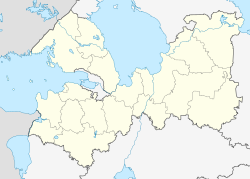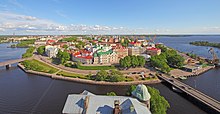Vyborg
| city
Vyborg
Выборг
|
||||||||||||||||||||||||||||||||||||||||||||
|
||||||||||||||||||||||||||||||||||||||||||||
|
||||||||||||||||||||||||||||||||||||||||||||
| List of cities in Russia | ||||||||||||||||||||||||||||||||||||||||||||
Vyborg ( transcription from Russian Выборг ; alternatively German Wiborg or outdated Wiburg ; Finnish Viipuri ; Swedish Viborg ) is a city in Leningrad Oblast in Russia . It is located in the historical Karelia region between Saint Petersburg and today's Finnish border and has 79,962 inhabitants (as of October 14, 2010).
The city, founded by the Swedes in the late Middle Ages , changed hands several times in the course of its history. From 1710 to 1917 Vyborg was part of the Russian Empire . From 1812 it belonged to the semi-autonomous Grand Duchy of Finland and from 1917 to the then independent Finland . Viipuri / Viborg was the second largest city in the country there. After the winter war of 1939–1940 it became part of the Soviet Union. Before that, practically the entire population had been evacuated to Finland. Until the end of World War I, the city's population consisted of numerous nationalities, in particular Finns , Russians , Swedes and Germans . Today it consists of over 90% Russians.
Surname
The Swedish name Wiborg / Viborg is a combination of vi "sanctuary" and borg "fortress". In Finnish, the original Swedish name (pronounced / viborj /) became Viipuri . The Russian name Выборг (pronounced / viborg /) is a transliteration of the Swedish name.
geography
In Vyborg, the Saimaa Canal, built in 1845–1856, flows into the Baltic Sea, which connects the Finnish Lake District ( Saimaa Lake ) with the Baltic Sea near Lappeenranta . Vyborg is on the Helsinki - Saint Petersburg railway line .
history
Vyborg was an important trading town in the Middle Ages. In the Northern Wars between Sweden and Teutonic Knights on the one hand and Alexander Newski of Novgorod on the other, Vyborg was a Swedish base against the Novgorod Rus . After several unsuccessful sieges (e.g. the siege of Vyborg in 1706 ) by Russian troops , the city surrendered to the Russian admiral Count Apraxin in the second siege of Vyborg on June 12, 1710 . Then it belonged to the Russian Empire , from 1812 to the Grand Duchy of Finland . In 1790, the Swedish fleet fled Vyborg Bay in what is known as the gauntlet of Vyborg .
At the end of the 19th century, Vyborg had six churches, an old Gothic castle, a grammar school and a navigation school . The city's port was economically important due to the timber trade , an iron foundry and local mechanical engineering . In 1886 the city had 16,639 inhabitants and was the seat of the governor of Vyborg , the court court for the three governorates of Kuopio , Mikkeli and Vyborg, a Lutheran consistory and a German consul.
In 1906, Liberal MPs met the recently by Tsar Nicholas II. Resolved first State Duma in Vyborg together and adopted the Vyborg manifesto , which called for civil disobedience against the state.
After the First World War, Vyborg fell to Finland, which had become independent . With almost 50,000 inhabitants, the city was the second largest in the new state at the time. In the winter war of 1939/40 and in the Continuation War of 1944 ( Vyborg-Petrozavodsk Operation ), the Soviet Union occupied most of Karelia, including Vyborg. The German minority , which has lived in Vyborg since the days of the Hanseatic League , left the city with the Finnish and Swedish residents in 1940 or was expelled after 1944.
Today the city belongs to Russia .
Population development
| year | Residents |
|---|---|
| 1886 | 16,639 |
| 1924 | 51,480 |
| 1939 | 74,403 |
| 1959 | 51,088 |
| 1970 | 65,188 |
| 1979 | 75,573 |
| 1989 | 80.924 |
| 2002 | 79,224 |
| 2010 | 79,962 |
Note: census data
Infrastructure
The Department of the North-Eastern Academy of Civil Service and a branch of the St. Petersburg State Engineering-Economic Academy are located in Vyborg.
An HVDC close coupling has been located near Vyborg since 1982 for the exchange of electrical energy between the Scandinavian and Russian power grids. It consists of three bipolar HVDC close couplings with an operating voltage of 85 kV, each designed for a transmission capacity of 355 megawatts, so the total transmission capacity is up to 1065 megawatts.
In Vyborg starts Baltic Sea pipeline company Nord Stream .
The city had a meter gauge electric tram from 1912 to 1957 , one of only three trams in Finland.
The train from Saint Petersburg to Helsinki stops in Vyborg several times a day.
Attractions
- Vyborg Castle, which is now open to the public, was built in 1293 on a small island as a bulwark by the Swedes . Today the interior houses a museum about the history of the region. The castle tower (Olafturm) offers a good view of the city.
- Defenses of the city (last extensions 1547–1550), in particular the round tower "Fat Katharina" on today's market square, which now houses a restaurant.
- Clock tower, erected in 1490. In 1793, Catherine II donated a bell for the tower.
- City library, built 1927–1935 by Alvar Aalto .
- Town houses from the Finnish period in the national-romantic style.
- Park and mansion Monrepos (see also map from 1902).
sons and daughters of the town
- Johann VII. Count von Hoya (1529–1574), Prince-Bishop of Osnabrück, Münster and Paderborn
- Ludwig Heinrich von Nicolay (1737–1820), poet and president of the Russian Academy of Sciences in Saint Petersburg
- Franz Franzewitsch Reineken (1746–1821), German-Baltic major in the Imperial Russian Army, commander in Kamchatka
- Maximilian von Alopaeus (1748–1821), Russian diplomat
- Hermann Johann von Benckendorff (1751–1800), Russian officer
- David von Alopaeus (1769–1831), Russian diplomat
- Wladimir Adlerberg (1791–1884), Russian general and minister
- Carl Ferdinand Jänisch (1813–1872), Russian chess master
- Julius Krohn (1835–1888), Finnish poet
- Johan Jacob Ahrenberg (1847–1914), Finnish-Swedish writer and architect
- Bror Brenner (1855–1923), Finnish sailor
- Carl Eduard Dippell (1855–1912), Finnish architect
- Werner Söderhjelm (1859–1931), Finnish linguist
- Eero Järnefelt (1863–1937), Finnish painter
- Victor Hackman (1866–1941), Finnish geologist
- Richard Wilhelm Gottlieb Faltin (1867–1952), Finnish surgeon
- Oskar Hackman (1868–1922), Finnish-Swedish folklorist
- Armas Järnefelt (1869–1958), Finnish composer
- Georg Schnéevoigt (1872–1947), Finnish conductor and cellist
- Waldemar Björkstén (1873–1933), Finnish sailor
- Ernst Mielck (1877–1899), Finnish pianist and composer
- Walter Wahl (1879–1970), Finnish geochemist and mineralogist
- Lew Galler (1883–1950), Soviet admiral
- Villehad Forssman (1884–1944), Swedish engineer and aircraft designer
- Alfred Asikainen (1888–1942), Finnish wrestler
- Allan Franck (1888–1963), Finnish sailor
- Sulo Jääskeläinen (1890–1942), Finnish ski jumper and Nordic combined athlete
- Pekka Myrberg (1892–1976), Finnish mathematician
- Aleksanteri Toivola (1893-1987), Finnish wrestler
- Edwin Linkomies (1894–1963), Finnish literary scholar and politician
- Ilmari Manninen (1894–1933), Finnish ethnographer
- Aarne Pekkalainen (1895–1958), Finnish sailor
- Ernst Ossian Soravuo (1904–1994), Finnish diplomat
- Arvo Närvänen (1905–1982), Finnish bandy and soccer player
- Aili Konttinen (1906–1969), Finnish author
- Henry Parland (1908–1930), Finnish-Swedish poet and writer
- Peter Karstedt (1909–1988), German lawyer and librarian
- Thure Georg Sahama (1910–1983), Finnish geologist and mineralogist
- Kaj Franck (1911–1989), Finnish designer
- Aleksanteri Saarvala (1913–1989), Finnish gymnast
- Michail Bogdanow (1914–1995), Russian production designer and art director
- Ralf Parland (1914–1995), Finnish-Swedish writer, poet and translator
- Veikko Huhtanen (1919–1976), Finnish gymnast
- Lauri Törni (1919–1965), Finnish officer
- Max Jakobson (1923–2013), Finnish diplomat
- Olavi Rokka (1925–2011), Finnish modern pentathlon
- Yrjö Asikainen (1928–2008), Finnish football player
- Veijo Meri (1928–2015), Finnish writer
- Jorma Valkama (1928–1962), Finnish athlete
- Paul Nyman (* 1929), Finnish cyclist
- Olavi Mannonen (* 1930), Finnish modern pentathlon
- Martti Ahtisaari (* 1937), Finnish diplomat and President 1994–2000
- Natalja Gorbatschowa (* 1947), discus thrower
- Vyacheslav Yekimov (* 1966), Russian racing cyclist
- Yevgeny Bersin (* 1970), Russian racing cyclist
- Alexander Serow (* 1982), Russian racing cyclist
- Vitaly Petrov (* 1984), Russian automobile racing driver
- Dmitri Wladimirowitsch Strachow (* 1995), Russian cyclist
- Kirill Alexejenko (* 1997), Russian chess player
- Vitaly Ivanov (* 1998), Russian Nordic combined athlete
Others
Wyborg plays an essential role in Friedrich Wilhelm Murnau's film " Nosferatu ". The Wisborg mentioned there apparently means Vyborg at the extreme end of the Baltic Sea and the Gulf of Finland. Murnau deliberately deviates here from the English model of Bram Stoker " Dracula ".
See also
- List of cities in Leningrad Oblast
- Vyborg side , historic district of St. Petersburg
Web links
- Vyborg (English, Russian)
- http://www.vbg.ru/
- http://www.nortfort.ru/vyborg/
- http://www.aviavyborg.ru/
- http://www.towns.ru/towns/viborg_en.html
- The virtual Wiburg 1939 (Finnish, English)
Individual evidence
- ↑ a b Itogi Vserossijskoj perepisi naselenija 2010 goda. Tom 1. Čislennostʹ i razmeščenie naselenija (Results of the All-Russian Census 2010. Volume 1. Number and distribution of the population). Tables 5 , pp. 12-209; 11 , pp. 312–979 (download from the website of the Federal Service for State Statistics of the Russian Federation)
- ^ Store norske leksikon, Viborg







